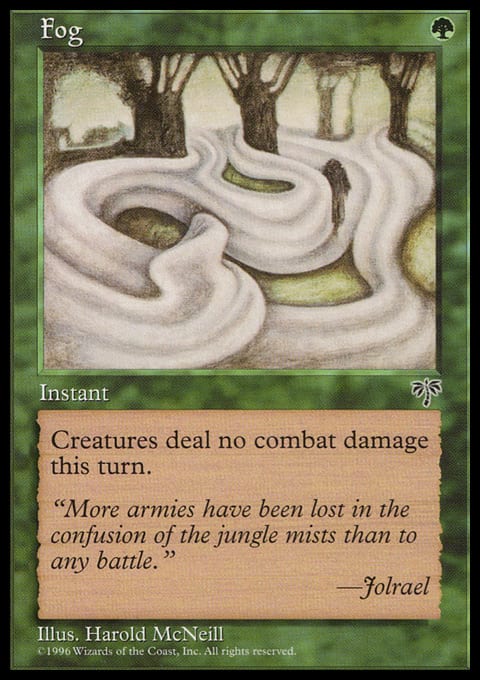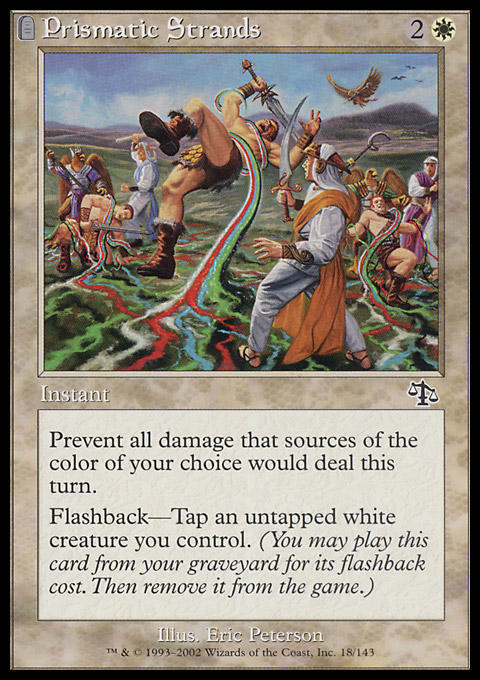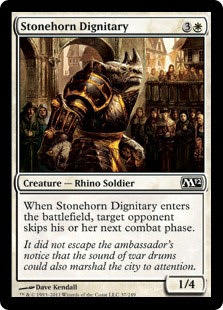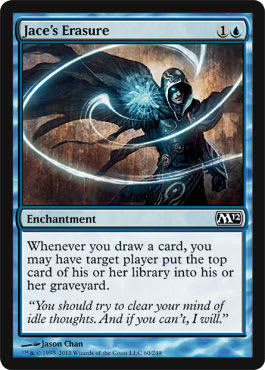When Dinrova Horror was added to the Pauper cardpool with Modern Masters 2017, a new breed of Tron deck emerged. Prior to the introduction of the Gatecrash downshift, the two most successful versions of Tron fell into two camps. The first was a deck that tried to assemble the mana engine quickly with Expedition Map and Ancient Stirrings supported by a light removal suite and then Murasa Tron which was a control deck that leveraged the mana advantage for late game dominance. Dinrova Horror added another option. It gave the Tron engine another spout in looping the 4/4 with Ghostly Flicker and Mnemonic Wall. It diverged from previous Tron decks by moving almost entirely away from removal and instead relied on Moment's Peace to survive to its endgame.
Dinrova Tron ? Pauper | LeroyB, 5-0 Pauper League, March 24, 2017
- Creatures (12)
- 2 Mnemonic Wall
- 3 Dinrova Horror
- 3 Sea Gate Oracle
- 4 Mulldrifter
- Instants (18)
- 1 Pulse of Murasa
- 2 Condescend
- 2 Crop Rotation
- 2 Exclude
- 2 Forbidden Alchemy
- 2 Ghostly Flicker
- 2 Mystical Teachings
- 2 Prohibit
- 3 Moment's Peace
- Artifacts (7)
- 1 Dimir Signet
- 2 Expedition Map
- 4 Prophetic Prism
- Lands (23)
- 2 Island
- 1 Bojuka Bog
- 1 Remote Isle
- 3 Shimmering Grotto
- 4 Thornwood Falls
- 4 Urza's Mine
- 4 Urza's Power Plant
- 4 Urza's Tower
- Sideboard (14)
- 1 Ancient Grudge
- 1 Crop Rotation
- 1 Moment's Peace
- 1 Probe
- 1 Pulse of Murasa
- 1 Radiant Fountain
- 1 Ray of Revelation
- 2 Electrickery
- 2 Hydroblast
- 3 Dispel
Dinrova Tron helped to highlight a truth about Pauper as a format. The vast majority of games in Pauper end during the combat phase. Despite access to a wide array of strategies, both aggressive decks and combo decks need to rely on attacking to win. This, coupled with the lack of cards that can efficiently deal with multiple threats, makes Fog effects attractive as a way to prolong games in Pauper. Decks like Dinrova Tron have a dominating endgame; and, without Damnation style cards to get you there, the next best thing is preventing the aggressive decks from depleting your life total.
Despite being available to the format for much of its history, Fogs have taken on a new importance this year. The advent of the Monarch mechanic, showcased in Entourage of Trest, Palace Sentinels, and Thorn of the Black Rose, put a premium on not taking any combat damage. A personal Howling Mine is worth defending and these cards have influenced deck design like few other mechanics. Damage prevention effects give Monarch decks a chance to draw into more removal to take care of offending threats since a Day of Judgment is not coming off the top anytime soon.
The increase in combo decks also makes turning to Moment's Peace and its friends an interesting option. Recently Gush fueled decks have become more popular. Nivix Cyclops, Kiln Fiend, and Tireless Tribe all have to attack to win the game. These are the lynch pins of Pauper’s combo decks and the opportunity to gain an edge against a wide swath of decks by blanking the combat phase makes running a deck that leans on Fogs a reasonable option.
There are plenty of good Fogs in Pauper. On top of the original Fog, which has the advantage of costing a single mana, Green has an abundance of options. Moment's Peace is perhaps the best thanks to Flashback, getting two turns of safety out of a single card. Tangle is a close second as it can lock down attackers for two turns. Tangle is marginally worse due to the presence of Quirion Ranger and Nettle Sentinel but still holds down most non-Green beatdown decks. Respite has the advantage of providing a life buffer which in the right situation can be almost as good as two Fogs (although the second half doesn’t stop the Monarch from changing hands). Green also has Spore Frog and Haze Frog as creature based preventative measures. Haze Frog is an expensive option that has the advantage of dodging Dispel but Spore Frog sees more play due to the minimal casting cost.
White also plays in the mist. Kami of False Hope is a color shifted Spore Frog while Holy Day is a re-skinned Fog. Prismatic Strands is a format staple for its ability to prevent damage outside of combat and also gives the caster the ability to selectively prevent. Pair this with Flashback and you have a reason to run White. Dawn Charm has multiple modes and can not only prevent attackers from doing their job but also shuts down Rolling Thunder. Riot Control is more expensive than Respite but has the upside of gaining life for each creature, not just each one in the red zone.
There are other cards that mimic actual Fogs. Feeling of Dread can shut down up to four attackers each turn; Rhystic Circle can turn off all damage if you feed enough mana into it; Stonehorn Dignitary can turn off combat for real; Gigadrowse and Downsize get Blue in on the game. There are also plenty of spells that tap down creatures for two turns a la Blinding Beam or Frost Lynx. These are all reasonable inclusions in a Fog build.
Running a Moment's Peace deck comes with some inherent risks. First is the vulnerability to Burn. Burn is never the most popular deck but it acts as a limiting factor for some of the looser builds that show up in Pauper. Despite running a good number of creatures, Burn rarely attacks. Outside of Prismatic Strands, none of the damage prevention effects can reliably turn off an onslaught of Lightning Bolts and similar cards. Back this up with Flaring Pain — a card that is tailor made to hose these decks — and Burn can be a nightmare matchup.
Flaring Pain is a real pain. It turns off damage prevention for two turns and shows up often in the sideboard of the Nivix Cyclops-Kiln Fiend Izzet Blitz deck. Since that deck often needs only one combat phase to win it can just hold off until it finds the instant and just win. Due to the existence of Flaring Pain I have a hard time advocating any Fog deck that does not run Blue since it can counter the sideboard all star.
These decks are also soft to counterspells themselves. Mono-Blue Delver can be especially troublesome since it can apply pressure while also countering spells on key turns. The ability to deal damage early and often while also making the ability to prevent damage less reliable means that Fog decks will be hard pressed to win.
Therein resides the final impediment to these decks — their strategy is based around not losing as opposed to winning. Fog decks have to consider their victory condition second after surviving. If the reason for running Moment's Peace and its kin is the ability to stop your opponent from emerging victorious, eventually you will have to figure out how to end the game yourself.
While not a pure Fog deck, Dinrova Tron shows how the mana abundance provided by the Tron engine can be leveraged into wins. There are other decks that seek to make use of the UrzaTron to fuel their pillow fort ways. One tries to use Rhystic Circle to shut down all potential damage and then end the game with Ulamog's Crusher. While this strategy is a true lock down, it is very click heavy which makes it less ideal for Magic Online. There is another deck that uses a White element to lockdown the game — Stonehorn Tron.
Stonehorn Tron ? Pauper | TomatoCheese, Top 8 November 5 Pauper Challenge
- Creatures (11)
- 1 Ulamog's Crusher
- 2 Mnemonic Wall
- 2 Sea Gate Oracle
- 2 Stonehorn Dignitary
- 4 Mulldrifter
- Instants (13)
- 1 Moment's Peace
- 2 Ghostly Flicker
- 2 Prohibit
- 2 Pulse of Murasa
- 3 Condescend
- 3 Repeal
- Sorceries (4)
- 1 Rolling Thunder
- 3 Compulsive Research
- Artifacts (9)
- 1 Serrated Arrows
- 4 Expedition Map
- 4 Prophetic Prism
- Lands (23)
- 2 Island
- 1 Shimmering Grotto
- 1 Tranquil Cove
- 1 Unknown Shores
- 2 Swiftwater Cliffs
- 4 Thornwood Falls
- 4 Urza's Mine
- 4 Urza's Power Plant
- 4 Urza's Tower
- Sideboard (15)
- 1 Ulamog's Crusher
- 1 Moment's Peace
- 1 Serrated Arrows
- 1 Circle of Protection Red
- 1 Coalition Honor Guard
- 1 Gorilla Shaman
- 1 Leave No Trace
- 2 Ancient Grudge
- 2 Dispel
- 4 Hydroblast
Stonehorn Dignitary has shown up in the sideboards of decks featuring the Mnemonic Wall/Ghostly Flicker package for quite some time. Working in concert, these cards can take away the opponent’s ability to attack full stop. When paired with the mana surplus provided by the UrzaTron the deck can also deploy threats while protecting its life total. From there it becomes a matter of finding Rolling Thunder to end the game in one or turns thanks to a sufficiently large burn spell.
When Pauper people think about Fog based decks, however, they do not tend to think about Tron. Despite the fact that this build and Dinrova Tron both lean heavily on the ability to prevent damage, when Moment's Peace is brought up it is done in reference to Turbo Fog. Pauper TurboFog is almost always a ![]()
![]() deck that uses its Fogs to buy time for a rather passive win condition to take over. What is that win condition? Jace's Erasure.
deck that uses its Fogs to buy time for a rather passive win condition to take over. What is that win condition? Jace's Erasure.
Pauper does not have access to many passive ways to win the game. There are no Planeswalkers with their ultimate ability, and very few artifacts that have a meaningful long-term impact. Cards like Jace's Erasure, Curse of the Pierced Heart, and Curse of the Bloody Tome are able to just sit there and help you win the game. Jace's Erasure is often the centerpiece of TurboFog decks because it can remove multiple cards per turn. A single Curse of the Bloody Tome has a cap of reducing the library by two cards per turn. Jace's Erasure starts at one and can increase with card draw spells, and who doesn’t love drawing cards?
The most common iteration of Turbo Fog runs Gush and other powerful Blue spells to power up Erasure. Combined with Accumulated Knowledge, Brainstorm, and Compulsive Research it isn’t hard for this iteration of the deck to dump five or six cards into a graveyard per turn. A second Erasure doubles the damage and makes victory that much easier to obtain. These builds also completely avoid creatures as a way to blank the removal prevalent in the format. By attacking the game from a completely different angle, it can often gain an edge and catch the adversary off guard.
Turbo Fog ? Pauper | robsonsmith, 5-0 Pauper League December 5, 2017
- Instants (27)
- 2 Gush
- 2 Moment's Peace
- 2 Muddle the Mixture
- 2 Respite
- 3 Arcane Denial
- 4 Accumulated Knowledge
- 4 Brainstorm
- 4 Fog
- 4 Tangle
- Sorceries (11)
- 1 Ideas Unbound
- 2 Compulsive Research
- 4 Ponder
- 4 Preordain
- Enchantments (4)
- 4 Jace's Erasure
- Lands (18)
- 2 Forest
- 6 Island
- 2 Simic Growth Chamber
- 4 Evolving Wilds
- 4 Thornwood Falls
- Sideboard (15)
- 1 Reclaim
- 2 Nourish
- 3 Counterspell
- 3 Dispel
- 3 Hydroblast
- 3 Spreading Seas
Jace's Erasure is key to making this deck work, so to supplement the four copies this version also runs two Muddle the Mixture. Not only does Muddle help to defend the win condition in a light counter war, it can also tutor for the Erasure and most Fog effects. Arcane Denial also finds a home as a counter that can also deplete a library. Denial has the advantage of drawing you three cards if you decide to point it at your own spell.
While this version is more common, I do not believe it is the only way to build a ![]()
![]() Turbo Fog list. Whereas this version leans heavily on Gush to power up its Erasure, I find the spell a bit lacking. Mono-Blue Jace's Erasure decks are able to pair Gush with Whirlpool Rider which means a single Erasure can take out around ten cards in a given turn. The Simic builds do not want to shuffle away their hands due to their reliance on the ability to prevent damage. When investigating this archetype, I decided to borrow some technology from Boros Monarch and pair Jace's Erasure with the newly release Entourage of Trest. Entourage is uniquely positioned in these decks as it can come down and immediately block two creatures, helping to ease the burden placed on Moment's Peace and friends. Entourage also naturally encourages Erasure while drawing you into more Fogs without an additional mana investment.
Turbo Fog list. Whereas this version leans heavily on Gush to power up its Erasure, I find the spell a bit lacking. Mono-Blue Jace's Erasure decks are able to pair Gush with Whirlpool Rider which means a single Erasure can take out around ten cards in a given turn. The Simic builds do not want to shuffle away their hands due to their reliance on the ability to prevent damage. When investigating this archetype, I decided to borrow some technology from Boros Monarch and pair Jace's Erasure with the newly release Entourage of Trest. Entourage is uniquely positioned in these decks as it can come down and immediately block two creatures, helping to ease the burden placed on Moment's Peace and friends. Entourage also naturally encourages Erasure while drawing you into more Fogs without an additional mana investment.
Running Entourage, however, means changing the Fog suite. Spore Frog becomes more important as you want to be able to tap out on turn five while still protecting your life total. Once you move away from the “no creatures” model, Archaeomancer and its ilk make sense as additional copies of Fog. While I only ran one main in my initial build, if I were to play the deck again I would find space for a second as well as a copy of Ghostly Flicker. This small package would allow me to recur Fogs easily while also resetting a lost Monarch. The last creature I ran was a single copy of Battlefield Scrounger which gave me the opportunity to win via damage while also making sure that if the game went long I would be safe.
Rather than Muddle the Mixture I opted to run Vessel of Nascency. Not only does Vessel find copies of Erasure but it also can draw half a Moment's Peace, fill the graveyard with Accumulated Knowledge and Deep Analysis, and also helps to find Spore Frog or Entourage. Running Vessel also gave me the opportunity to run two copies of Pulse of Murasa. Pulse not only helps keep you alive but it can also retrieve key creatures, namely Spore Frog, from the bin.
Rounding out the differences were bounce spells. I ran two copies of Winds of Rebuke as a way to mitigate early threats while also advancing my game plan. Repeal slotted in as another spell that could protect life points while also potentially milling the opponent. Neither of these impressed me much.
I was very happy with this deck and ran it to a 3-2 record in the league. I was one card away from 4-1 but in Game 3 of round five the very last card in my Elves opponent’s deck was Mob Justice and I did not have a Hydroblast.
Monarch Fog ? Pauper | Alex Ullman
- Creatures (8)
- 1 Archaeomancer
- 1 Battlefield Scrounger
- 2 Entourage of Trest
- 4 Spore Frog
- Instants (23)
- 1 Repeal
- 2 Pulse of Murasa
- 2 Respite
- 2 Winds of Rebuke
- 4 Accumulated Knowledge
- 4 Brainstorm
- 4 Moment's Peace
- 4 Tangle
- Sorceries (2)
- 2 Deep Analysis
- Enchantments (6)
- 2 Vessel of Nascency
- 4 Jace's Erasure
- Lands (21)
- 5 Forest
- 5 Island
- 1 Lonely Sandbar
- 1 Tranquil Thicket
- 2 Simic Growth Chamber
- 3 Ash Barrens
- 4 Thornwood Falls
- Sideboard (15)
- 1 Archaeomancer
- 1 Feed the Clan
- 1 Pulse of Murasa
- 2 Claws of Wirewood
- 2 Dispel
- 2 Echoing Truth
- 3 Hydroblast
- 3 Natural State
Moving forward, I would use this as the base for Turbo Fog strategies. It is less combo orientated than the Gush version while also better suited to win games where you don’t draw as many Fogs as sometimes a 4/4 does a good job of attacking. I was not sold on Scrounger and could see replacing it with another Entourage. As mentioned, the bounce package was lackluster and adding a second copy of Archaeomancer and a Ghostly Flicker might be the way to go. Finally, I might find room for a Haze Frog just as another way to blunt assaults.
Turbo Fog strategies exist at the fringes of the Pauper metagame. They thrive when all anyone wants to do is attack. Thankfully in Pauper, the combat step is vital. Whether you choose to simply deny them the step entirely or make it less effective, Turbo Fog is a fun way to wins games with something different. It also happens to have the side benefit of being miserable to play against.


























